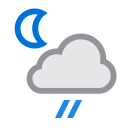Current Weather in Bariloche
 Patchy rain possible
Patchy rain possible17°C62.6°F
- Current Temperature: 17°C62.6°F
- Current Feels‑Like Temperature: 17°C62.6°F
- Current Humidity: 83%
- Minimum Temperature/Maximum Temperature: 12°C53.5°F / 23.8°C74.8°F
- Wind Speed: 18km/h
- Wind Direction: ↑ From the West
(Data Time 20:00 / Data Retrieved 2025-08-29 16:30)
Seasonal Events & Climate in Bariloche
Argentina is located in the Southern Hemisphere, and the seasons are reversed compared to Japan. For convenience, this content will categorize each month according to "Japanese seasonal names," while also introducing the local climate characteristics and representative events and culture.
Spring (March to May)
Climate Characteristics
- Temperature: The summer heat eases, with an average of around 25°C in March and a drop to around 15°C by May.
- Precipitation: March to April sees relatively high rainfall, while it tends to be drier after May.
- Characteristics: There is a significant temperature difference between morning and evening, and there is a possibility of early frost in the southern regions.
Major Events and Culture
| Month | Event | Description and Relation to Climate |
|---|---|---|
| March | Festival Nacional de la Vendimia (Grape Harvest Festival) | Held mainly in Mendoza Province. Outdoor parades and wine tastings take place in the vineyards at harvest time. |
| March-April | Semana Santa (Holy Week) | A Christian ritual with processions on the streets and masses in churches, held in a seasonal atmosphere that signals the end of the rainy season. |
| April | Día del Trabajador (Labor Day) | Officially on May 1st. Demonstrations and gatherings occur nationwide, characterized by decorated public assemblies in the autumn coolness. |
| May | Día de la Revolución de Mayo (May 25th) | Commemorates the May Revolution of 1810. Large parades and concerts are held in the capital, Buenos Aires. |
Summer (June to August)
Climate Characteristics
- Temperature: It is winter, with temperatures around 15°C in June and many days below 10°C in July and August (particularly in the southern Patagonia).
- Precipitation: Generally a dry season; mist and light rain can be observed in some urban areas and northern regions.
- Characteristics: Cold winds strengthen, and there are days of severe cold in the central Pampa region.
Major Events and Culture
| Month | Event | Description and Relation to Climate |
|---|---|---|
| June | Día de la Bandera (Flag Day) | A day to honor General Manuel Belgrano. Ceremonies are held in Buenos Aires, creating a solemn atmosphere under winter sunshine. |
| July | Día de la Independencia (Independence Day) | Celebrates the declaration of independence in 1816. Military parades and fireworks occur nationwide, shining against the clear winter air. |
| July-August | Fiesta Nacional de la Nieve (National Snow Festival) | Held in Bariloche, Patagonia. A winter leisure event featuring skiing and snow sculpture contests, celebrating the snow. |
Autumn (September to November)
Climate Characteristics
- Temperature: It rises with the arrival of spring, reaching around 15°C in September and nearly 25°C in November.
- Precipitation: Generally a dry season except in the south. Occasional spring rains begin, along with the dispersal of pollen.
- Characteristics: Plants sprout simultaneously, creating a climate ideal for outdoor events.
Major Events and Culture
| Month | Event | Description and Relation to Climate |
|---|---|---|
| September | Primavera Porteña (Buenos Aires Spring Festival) | Food markets and concerts are held in urban areas, enjoyable in mild temperatures. |
| October | Fiesta de la Cerveza (Oktoberfest) | A beer festival influenced by German immigrants. Beer tastings and folk dances are conducted outdoors under refreshing spring weather. |
| November | Día de la Tradición (Tradition Day) | An event celebrating local culture and gaucho (Argentine cowboy) culture, featuring outdoor equestrian shows. |
Winter (December to February)
Climate Characteristics
- Temperature: It is summer, with around 25°C in December and many days exceeding 30°C in January and February.
- Precipitation: Summer rainy season. Thunderstorms and heavy rains are likely, with increased humidity.
- Characteristics: Hot and humid days increase due to tropical depressions and heat waves.
Major Events and Culture
| Month | Event | Description and Relation to Climate |
|---|---|---|
| December | Navidad (Christmas) | Illumination in public squares and shopping malls. A custom of family gatherings during long summer nights is established. |
| January | Carnaval | Costume parades occur in Buenos Aires and other regions, lively as outdoor parties during tropical nights. |
| February | Whale Festival in Puerto Madryn | A season for observing humpback whales along the Patagonian coast. Eco-tours and hands-on workshops take place in warm sea breezes. |
Summary of Seasonal Events and Climate Relation
| Season | Climate Characteristics | Major Event Examples |
|---|---|---|
| Spring | Transition from summer to autumn, refreshing winds after the rainy season | Grape Harvest Festival, Holy Week, Independence Day (May 25) |
| Summer | Cold winter period, dry sunny weather | Flag Day, Independence Day (July 9), Snow Festival |
| Autumn | Pollen dispersal, budding plants, dry period | Spring Festival, Oktoberfest, Tradition Day |
| Winter | Hot and humid, thunderstorms and heavy rains in the rainy season | Christmas, Carnaval, Whale Festival |
Additional Notes
- Due to the country's long north-south geography, there are differences in climate variations and event timings depending on the region.
- The grape harvest festival in Mendoza is one of Argentina's top tourist attractions.
- Major cities feature many events influenced by European immigrant cultures, blending traditional and modern cultures.
- Environmental conservation activities and eco-tourism are also important cultural elements in each season.
Please refer to the vibrant seasonal events that reflect Argentina's diverse climate and culture when planning your visit.